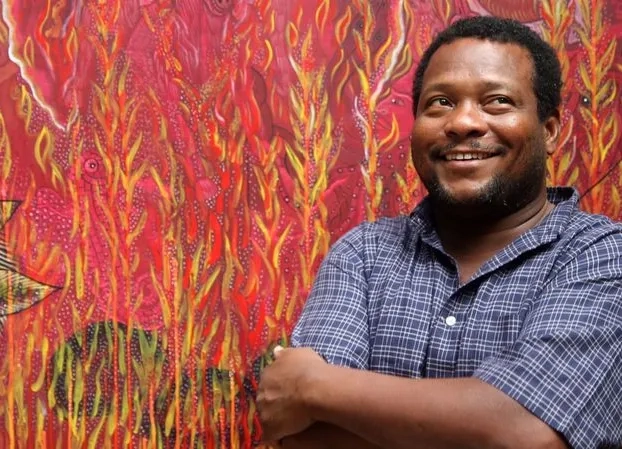
Frantz Zephirin was born in Cap-Haitien on December 17, 1968 to an architect father and a mother who was a nurse. Frantz was raised by his grandmother, an embroiderer. ”When I was very young, I already drew models and flowers” consequently in 1973 he began painting with his uncle, the painter Capois Antoine Obin. Having grown up in an artistic universe, he learned to read at the same time he started painting. At the age of 7, he sold his landscapes and small paintings to cruise ship tourists visiting Cap-Haitien. In 1983 he left his family in Cap-Haitien and moved to Port-au-Prince to continue his classical studies and dedicate himself entirely to painting. At that time he joined the Monnin Gallery. From 1988 he came to the Center d’Art and developed his own theme, his own style.
His paintings are inspired by history, politics, the environment, the Bible, and Haitian Creole culture, and Haiti voodoo. His work is immediately recognized by characteristics of bright colors with complex patterns that are highly compressed compositions of human figures with the heads of wild or domestic animals, mystical figures, and parallel worlds. Frantz Zephirin makes the world ironic by caricaturing men from the country’s ruling class. Not without cynicism, he describes himself as a “historical animalist” and with a wry smile says ”Look closely in every man there is an animal; a fox, an ape, a cat, usually reflected as a characteristic in an individual”.
In 1994 he received the Swiss Prize and the Europe Prize for Modern Primitive Painting, at Kasper Pro Arte, Morges, Switzerland. In October 1996 he received the gold medal at the third biennial of Caribbean and Central American painting at the Museum of Modern Art in the Dominican Republic: Zephirin was one of the five Haitians participating in the V Biennial of Cuenca, Ecuador. He also participated in the “Sacred Arts of Haitian Voodoo” exhibition, which toured the United States between 1997-1998.
in 1999, his painting appeared on the cover of Bob Shacochis’s book entitled, The Immaculate Invasion, a New York Times bestseller. His work appeared in two major exhibitions at the American Museum of Visionary Art, “Today H20”, in 2004-2005 and “Home & Beast” in 2006-2007. Frantz Zephirin’s paintings are part of the collections of international museums such as the Afrika Museum, Berg-en-Dal, the Netherlands; and the Waterloo Museum. In September 2010, his painting was featured on the cover of Smithsonian magazine, reporting on the rescue of Haitian cultural property after the January 12, 2010 earthquake. His paintings have also been included in other prestigious magazines including: Le Temps, New York Times, The World, The Wall Street Journal, Los Angeles Times, The Times of London, The Guardian and the BBC, including their websites. His painting “The Resurrection of the Dead” was the selected image chosen for the cover of the New Yorker magazine for their January 25 edition.
In 2013-2014, he participated in the exhibition Aquatopia the Imaginary of the Ocean Deep, at the Sahm workshops in Brazzaville as part of an artist residency. During the second edition of the International Plano festival in 2018, Frantz Zephirin’s painting gave a second life to the Pleyel piano at the Residence de France in Haiti, destroyed during the 2010 Earthquake.
Frantz Zephirin is a voodoo priest who has a studio in his temple, “the Temple of the Seven Virgins”, high on a mountain overlooking Mariani, outside of Port-au-Prince.
Due to the political strife in his homeland Frantz is currently painting in the Dominican Republic and opened a gallery in Santo Domingo in 2021 and in 2022 combined his efforts with long time friend and gallerist Frank Giannetta to establish Zephirin/Giannetta Galleries.
Frantz had two pieces selected and are currently exhibited at the 2022 Venice Biennale, that runs through November 27, 2022.
He is currently working on a new project interconnecting aspects of earth and the cosmos.